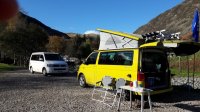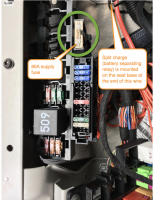Running the engine doesn’t “ trickle charge “ the Leisure Battery but can put some serious amps into the Leisure Battery. That is why there is an 80 amp fuse in the Split Charge System . If the Leisure Battery was very flat prior to engine start then this fuse could have blown.
It is a Large Brown Fuse, twice the size of the standard fuses, found under the Passenger Seat in a separate fuse carrier.
Good information WelshGas. I do not have a battery monitor like you do on an Ocean, just the solar charger unit that shows either 0, 1, 2, 3, 4 or 5 bars lit.
I'm assuming the following:
Blank screen dead battery
0 bars 0-10% charge
1 bar 10-30%
2 bars 30-50%
3 bars 50-70%
4 bars 70-90%
5 bars 90-100%
On Monday morning the charger was flashing 0 bars for the first time.
We then drove for about 2h30 in bright sunlight and stopped overnight using only internal lights.
Yesterday we drove about 5h30, mostly blasting along the Autostrada, in a mixture of sunlight and cloud.
I am thinking, based on what you have said about the engine putting "serious amps" into the leisure battery, that two winter days of sunlight and cloud has charged the leisure battery from 0-10% charge to 50-70% charge and the 80 amp fuse has blown meaning the leisure battery receives no charge from the engine.
I intend to confirm this after breakfast be noting the leisure battery voltage shown on the solar charger before and after starting the engine. If the voltage before and after is roughly the same the fuse is blown, if the voltage is higher then all is well.
Two questions:
1. Would you expect a 5 hour drive to fully recharge a single leisure battery?
2. Are the assumptions and thoughts I have on this reasonable?
Thanks, Tom
Follow my blog:
www.au-revoir.eu















